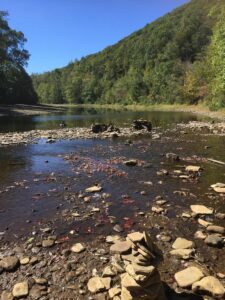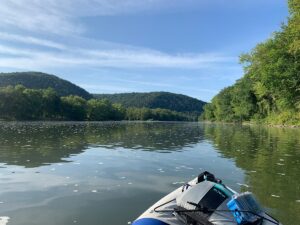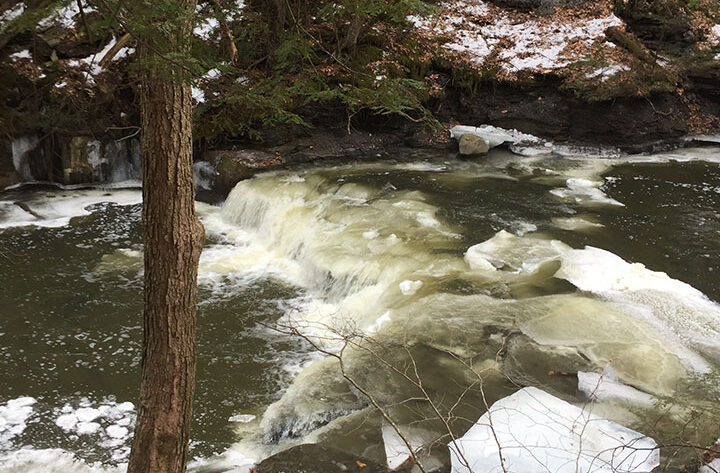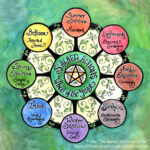I wanted to spend some time in my blog describing a journey I took last summer to see “the source” of a river. My work with the OBOD Druid grade initiated this journey, and it lead me to important insights about our world and how to create meaningful change in it.

Behind my parent’s house, in the forest to which I belong, is a creek (not quite a river, and not quite a stream). As children, we called it the “big crick”, and we spent much time on its banks, watching it flow over rocks, moss, and between hemlocks, beeches, and maple trees. This creek was located in the Appalachian mountains in West-Central PA, and unfortunately, the forest has been logged repeatedly, damaging the land in numerous ways. And yet, damaged, logged, and repeatedly violated, the spirit of the land is strong and has much to teach.
I set out on a journey to find “the source” of this river. I had a vision of what the source of the river looked like—it was tranquil with moss-covered stones. I had no idea how long it would take me, but I planned for being out the whole day and took food, drink, and a friend along for company. It ended up being about a 10 mile hike through the forest—and not just any forest, but forest that had been logged and otherwise terribly mistreated, so the going was slow. I went deeper into the forest than I ever had before, following the river. I saw a rare flower, which I discussed briefly in an earlier blog post. Each time it branched, I took the largest of the branches, continuing to work my way up the river, watching the river grow smaller. When I finally found the source of the river, of the largest branch, it was exactly as my inner vision had showed me—three branching streams, with the largest beginning in a spring with moss-covered stones. I sat there in meditation, and there, I had a meaningful vision. This was the message of my vision, and I know its something that I need to share with others:
When you follow a river to its source, follow the water’s path upstream and take the largest of the tributaries each time the river splits. This gives you a unique perspective, in that you can witness how the river, at its current size, is built of smaller tributaries. These tributaries, some permanent springs and other rain gullies and other seasonal contributors, aren’t just part of the river—they are the river. If you follow the river to its source, you will learn that each river starts off as a tiny stream or freshwater spring; the river only later grows larger as other tributaries feed into it. Each one of us is that stream; each one of us has the potential of that spring that starts the river off. It is only through the power of others, flowing together in unison, that we can be a river. The strength of a great river cannot be ignored—it shapes the landscape around it and brings significant change. We must unite, have a shared vision, and be that river.

The “Big Crick” is otherwise known as “Otto Run” and is located in Western Pennsylvania behind my parent’s home. This river has particular significance in expanding the general metaphor, so I’ll describe it here. Otto Run flows into the Little Conemaugh, which is a river of historical importance in my region’s history. The Little Conemaugh was once dammed up in the 1800’s, and in 1889 after severe rains and equally severe mismanagement of the dam, the dam burst and the resulting wave of water killed almost 3000 people in Johnstown, PA. This in itself has many lessons to teach us, including the importance of working with nature, rather than trying to tame her and bend her to one’s own will; she may resist such taming and break free.
The Little Conemaugh flows into the Conemaugh which flows into the Allegheny, which meets in Pittsburgh, PA with the Monongahela to form the Ohio. The Ohio leads right into the Mississippi River, one of the largest and most important rivers in the USA. Each of these rivers, with their many tributaries, creates the mighty Mississippi. And as our recent series of floods in 2011 and droughts in 2012 have demonstrated, despite the best efforts of many humans, the Mississippi cannot be tamed. This too, is a lesson for us. In these difficult times of struggle and environmental challenges, we must look to the lesson that the river teaches us. Each of us is that tributary, and by flowing in unison, we become as strong as the Mississippi. And nobody can stop the Mississippi.
So friends, remember the lesson of the river. United, we are strong. United, we can change this world into a better, more sustainable place.


I too grew up on a creek, the Gilkey. I spent every moment of daylight on it for almost 15 years. Minnows, turtles, dragonflies, crayfish, birds and rodents, with box elders overhanging. Even though it was closer to civilization than I’d ever have wished, it was sacred to my heart, and still is. It haunts my dreams at night – it is where, when anyone evokes the idea of ‘childhood’, my mind flows. It is like a permanent centre. Its source I knew well, many miles away, chaining from first the Kersley River, which I could visit in the wild woods across from my grandparents’ house 20 miles south, to the Flint River, to Lake Huron. It was alive, teeming. In my somewhat symbolic dreams if it were at peace, low and clear, life was going well, if it flooded, covering the back acres of our land, something troubling was going on in waking life. 35 years later these images still bubble up in confusing times. Your metaphors hold very true for me. Thank you for a marvelous post.
My forest haunts my dreams every night too. I think we share dreams, actually, and sometimes her fears and hopes for the future :).
This is a good metaphor that I shall remember. I read of the mighty River Dart in Dartmoor, UK coming into being from many small springs at its source.
Without meaning to sound contentious, Alex, the adjective “mighty” when linked to the dear old Dart is not the one that would have sprung to my little old mind! Well, having spent time close to the Mississippi and most of the major rivers of India, Thailand, Japan and China, I guess I’ve been spoiled somewhat. I was struck by the blackness of the river at Dartmeet when I strolled along the banks – but this was nearly 60 years ago, so things may have changed since then….
*Smiles* I have limited experience of the great rivers of the world, so the River Dart is mighty to my inexperienced eyes. Dartmoor has been getting plenty of rain in recent years, probably one of the places in UK getting the most rain.
Dana, it’s interesting how all kinds of disparate threads combine to make up a carpet or garment. You encapsulated, in your recent post, elements of Indian philosophy (the single raindrop falling into the sea and becoming thereby the very ocean), and these merged with my own prior musings on the theme of rivers in Western classical music. Bedřich Smetana depicted the twin sources of the Vltava in his famous symphonic poem of that name in Má Vlast. This, in turn, led my thoughts to Aaron Copland, reinforced by your own mention of Appalachia. Surprisingly, it was just last year – when I was a mere lad of 71! – that I heard that the word ‘spring’ in Appalachian Spring did not, as I had supposed, refer to the season, but to the source of a river mentioned in a Hart Crane poem.
Even your mention of the infamous Johnstown flood followed by a fire, (one of several inundations, actually), reinforced what I saw decades ago when I first arrived on one of the outer Hawai’ian islands. A relatively minor flood had washed away a bridge and caused some damage after the USDA (of all people!) foolishly bulldozed a large section of woodland and dense grass high up above the village. Had they never heard of soil erosion?! With humility and respect, and with patient observation, as you imply, we mere humans can give our Mother a helping hand, but only if we assiduously follow HER rules. Anything else is arrogance.
I hope some of this makes sense – my brain seems rather sluggish today. Also, I trust you received yesterday’s message from me. Frankly, I never know how these things are supposed to operate, and I believe I hid it away under your Deconstructing post of January 17. I’ve never ‘eavesdropped’ on a blog before, and sincerely hope I’m not doing the wrong thing or boring people.
You should be happy with the weather, Dana – some beautiful snow as Imbolc approaches. (I don’t know why you spell it in such an irregular fashion!) Then there’s groundhog day for a really accurate, scientific forecast! Just before I take my leave, I must mention that Purnima begged me to open Picasa on my external drive. Having done so, I sat back and told her to have a look at any pictures she wished to see. Inwardly chuckling, I watched her head straight for the photos of you -again – and speculate that just maybe you pretended to go to sleep on a mattress, and when all the other girls were asleep, you crept out to sleep in the elephant tree! (The furrowed, fissured bark of the cottonwood reminded us of elephants’ skin!) You really seem to have a devoted fan in India! So long!
Oh yes, I received your messages! I was not near the computer for most of yesterday, however, so I am only now able to respond.
I would prefer to sleep in trees to beds. They are most comforting. This time of year though, we are currently getting temperatures in the negatives (-3 F, which translates I think to about -20 for you). So tree sleeping will have to wait till spring returns again!
I very much enjoyed your entry. I never thought of visiting the source of a river.
There are 5 rivers that have their sources in Hillsdale County, where I live. The St. Joseph flowing into Lake Michigan, the St. Joseph of the Maumee, the Kalamazoo, the Grand and the Raisin. Spring fed, the rivers flow north, south, east and west from the highlands. The headwaters of the St. Joseph are close by me at Baw Beese Lake – and well-marked. I would like to venture to the headwaters of the other St. Joseph River since it is deep in the county’s woods. The other 3 rivers start from/near Somerset Lake in the Northeastern part of the county.
A few years ago I did some research online about the rivers – pretty cool, I think. This county is the only one in Michigan that has no water flowing into it, only out.
Ranthia, you aren’t that far from me at all! I was blogging about the river where I grew up (where my parents live). But actually, I live in Michigan now, near Clarkston (Oakland County). Thanks for sharing!